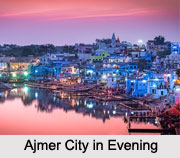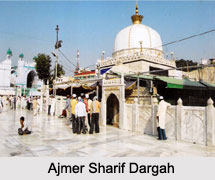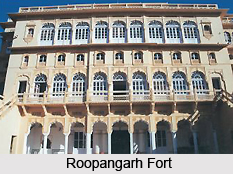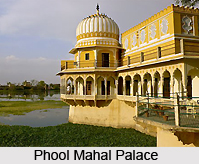Ajmer City
 Ajmer is known to the global tourism map for Ajmer Sharif Dargah, which is popular to both Hindus and Muslims. This holy city of Ajmer can be redefined as the green oasis amidst the barren hills of Rajasthan.
Ajmer is known to the global tourism map for Ajmer Sharif Dargah, which is popular to both Hindus and Muslims. This holy city of Ajmer can be redefined as the green oasis amidst the barren hills of Rajasthan.

Visiting Information
Ajmer is well connected to other cities of India and the most of the principle cities of Rajasthan by means of roadways, airways and railways. National Highway Number 8 is running between Delhi and Mumbai which passes through Ajmer city and Ajmer district. This National Highway covers a distance of about 147 kms. It also provides a direct road link from Beawar (old financial capital city of Mewar kingdom) to Delhi via Jaipur and Ajmer and to Ahmedabad via Udaipur. The nearest airport is Jaipur International Airport, which is 132 kilometers from the main city of Ajmer. Pushkar Ghati is the road that connects Ajmer with Pushkar.
Location of Ajmer
Ajmer is located in Ajmer District in the central part of North West Indian state, Rajasthan. The city is positioned on the foothills of Aravalli Mountain Range.
This land of composite cultures was founded by Raja Ajay Pal Chauhan in the 7th century A.D. Ajmer continued to be a major center of administration till the period when monarch of the Chauhan dynasty, Prithviraj Chauhan lost it to Mohammed Ghauri. But Chauhan rulers had to pay a heavy tribute to the conquerors to gain the power. Until 1365, Ajmer remained a feudatory of Delhi and was captured by the ruler of Mewar. In 1532, Ajmer was conquered by the Rathodes of Marwar. After that during the rule of British, Ajmer came under Rajputana Agency.
Geography of Ajmer
Ajmer is situated on the lower slopes of Aravalli Range. To the North of Ajmer, there located an artificial lake called Anasagar. Ajmer is surrounded by Jaipur and Tonk District (previously known as Princely State of Tonk) towards the East and Pali District in the West. The latitudinal and longitudinal limit of Ajmer is about 26.4499 degree North to 74.6399 degree East.
Demography of Ajmer
According to the population census in the year 2011, Ajmer had a total population of 2,584,913. The average literacy rate of Ajmer is about 70.46 percent. Out of which the male literacy rate is 83.93 percent and female literacy rate was 56.42 percent.
Ajmer is dotted with several Hindu temples, Jain temples and the mosques. Some of the popular places of attractions are Ajmer Sharif Dargah, Happy valley, Baradari, Anasagar Lake, Dargah of Syed Meeran Hussain Khing Sawar (one of the popular dargah in India), Taragarh Fort (known for the gates), Adhai Din Ka Jhonpda, Akbari Fort and Museum, Tomb of Khwaja Husain Ajmeri, Mayo College (a popular colonial architecture), Sai Baba Temple, Soniji Ki Nasiyan, Foy Sagar Lake and Nareli Jain Temple.
Accommodation in Ajmer City
 Ajmer is one of the most popular tourist destinations in Rajasthan. it is a holy city with several temples and mosques. However it would be wrong to say that only devotees throng the city. Tourists of all kinds come to this place to spend their vacations. To accommodate these travelers there are several accommodation units in Ajmer. The hotels here offer impressive services to the guests. The rooms are spacious and the ambience pleasant. The hotels in Ajmer will be suitable for the leisure and corporate travelers.
Ajmer is one of the most popular tourist destinations in Rajasthan. it is a holy city with several temples and mosques. However it would be wrong to say that only devotees throng the city. Tourists of all kinds come to this place to spend their vacations. To accommodate these travelers there are several accommodation units in Ajmer. The hotels here offer impressive services to the guests. The rooms are spacious and the ambience pleasant. The hotels in Ajmer will be suitable for the leisure and corporate travelers.
While some of the hotels are heritage ones the others are budget accommodation units.
The heritage hotels in Ajmer include:
• Amar Bagh Junia• Bijayniwas Palace Resort
• Tikam Niwas Mewar Estate
• Roopangarh Fort
 The rooms in these hotels are well furnished and the services at the heritage hotels include onsite restaurants, parking, laundry facilities, medical services, sightseeing tours and 24-hour room services.
The rooms in these hotels are well furnished and the services at the heritage hotels include onsite restaurants, parking, laundry facilities, medical services, sightseeing tours and 24-hour room services.
The Premium Hotels in Ajmer are few in number. These accommodations are perfect for those who want to spend their holidays amidst luxury. Hotels, such as, Mansingh Palace and Hotel Regency will be apt for both the leisure and business travelers. The rooms are spacious and plush. Multi cuisine restaurants and business services are also part of these hotels.
For those who want to keep a check on their pockets they can easily avail the budget hotels. The prices may differ but the hospitality and the services in the hotels of Ajmer hardly vary.
The budget accommodations in Ajmer comprise of:
• Hotel Pravasi Palace
• Hotel Ambassador
• Phool Mahal Palace
• Hotel Embassy
All kinds of facilities are arranged for the guests so that they have a comfortable stay.



















